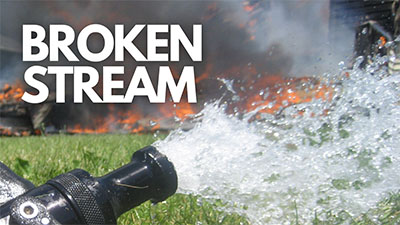The Broken Stream in Firefighting: What is it and Why do We Use It?
One of the many firefighting techniques employed by firefighters is the use of a broken stream. A broken stream can happen purposefully and be used effectively on the fire ground. They can also happen accidentally and be caused by nozzle damage or debris.
In this article, we are going to explore the broken stream when it is purposely created. We will talk through some advantages, disadvantages, and explore scenarios when firefighters might choose to use a broken stream.
What is a Broken Stream
A broken stream in firefighting refers to a disrupted water stream during firefighting operations that causes the water to separate rather than stay solid. It can occur due to accidental factors such as a kinked hose line near the nozzle inlet, damaged nozzles, or inadequate water pressure. It can also be done purposely by gating a ball valve nozzle on a smooth bore. This act interrupts the water flow and breaks the solid stream into divided droplets.
There are some positives and negatives to a broken stream that need to be considered before its use.
Pros of a Broken Stream
- Versatility in Specific Firefighting Scenarios: A broken stream can prove valuable in certain firefighting situations, especially if your crew relies on smooth bores. The broken stream can aid in ventilation and overhaul.
- Enhanced Ventilation Capabilities: By manipulating the water stream, you can encourage the release of smoke and heat through holes in the roof or walls. This ventilation technique enables improved visibility, enhances access to the fire area, and helps in keeping control during firefighting operations. It can also improve conditions for firefighters and potential victims inside of a structure.
Cons of a Broken Stream
- Limited Reach and Accuracy: The dispersed nature of a broken stream reduces its reach and accuracy compared to a solid stream. This limitation can be a disadvantage in situations that demand precise targeting of fire or long-distance applications.
- Lower Flow Rates: Gating your ball valve to create a broken stream also lowers your flow rate. This leads to less water making it to the fire and increases the chances of your crew providing insufficient water to suppress the flames.
Appropriate Usage Scenarios
Firefighters selectively use the broken stream technique in specific scenarios where its advantages outweigh the disadvantages. Some instances include:
- Hydraulic Ventilation: After creating an opening in a roof or wall, the broken stream can be used for ventilation and improving the conditions inside the structure. It can also be used for salvage and overhaul on your fire ground.
- Protection: Shielding adjacent structures or areas by deploying a broken stream as a water curtain to prevent fire spread.
To ensure safe and effective implementation of a broken stream, comprehensive training for firefighters is vital. Providing yourself and your department with regular instruction, hands-on practice, and information on current best practices is the best way to ensure a broken stream can be used correctly and safely.
Conclusion
The broken stream technique, despite its limitations, holds specific advantages in firefighting operations. By understanding its definition, pros, and cons, as well as the right scenarios for its use, firefighters can use it to their advantage.
It is important to remember, however, that better equipment may exist for creating a similar effect. While those that rely on smooth bore nozzles may choose to do a broken stream from time to time, a combination nozzle can create a fog pattern that may be more effective. Other equipment, such as the Vortex nozzle, can also create more uniform patterns and make a broken stream more predictable in fire ground scenarios without the loss of flow rate.
